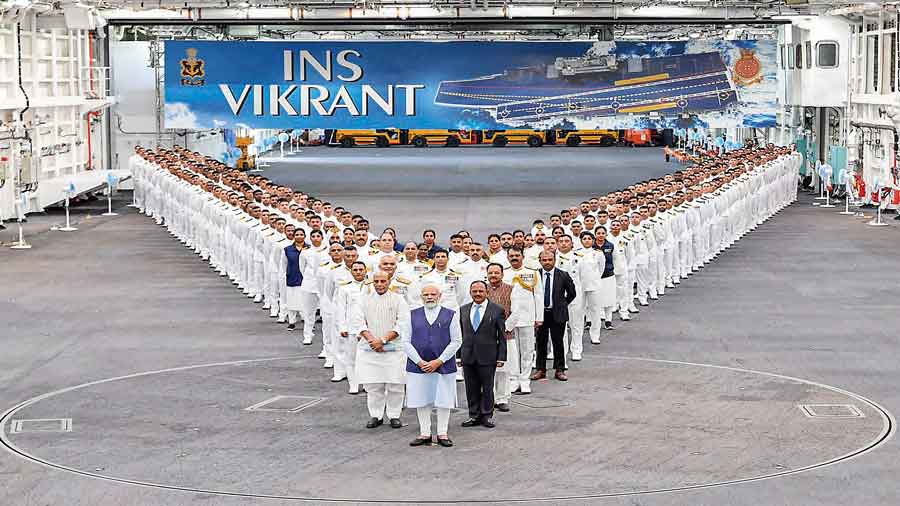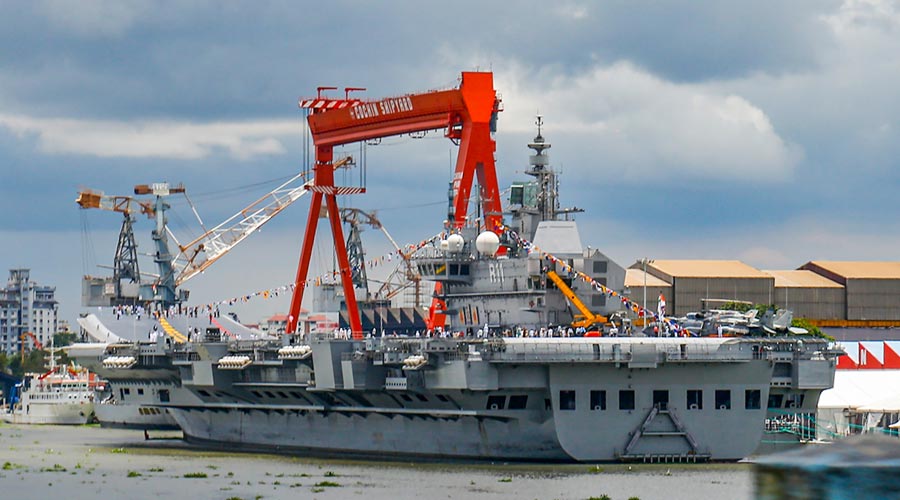INS Vikrant, India’s first indigenously built aircraft carrier, was formally commissioned by Prime Minister Narendra Modi on Friday at Cochin Shipyard Ltd in Kerala.
The Prime Minister projected the aircraft carrier as a shining beacon of his pet project, Atmanirbhar Bharat, but did not acknowledge that the previous government had launched the vessel in 2013. Modi told the gathering at the event: “The incomparable Amrit of Azadi Ka Amrit Mahotsav is Vikrant. Vikrant is a unique reflection of India becoming self-reliant.”
Later, Congress communications chief Jairam Ramesh underlined in a tweet: “Then defence minister AK Antony launched India’s first indigenous aircraft carrier INS Vikrant on 12.08.2013. The PM commissioned it today. A self-reliant (Atmanirbhar) India existed before 2014. All other Prime Ministers would have acknowledged continuity in governance.”
Military veteran Ajai Shukla tweeted: “It seems @narendramodi has no idea of the difference between an election speech and the speech that a prime minister shud deliver while commissioning an aircraft carrier. Its embarrassing to watch this military audience having to listen to, and clap at, politically loaded cracks.“
The @narendramodi govt has repeatedly said that INS Vikrant is a symbol of Atmanirbhar Bharat. He’s shooting himself thru (sic) the foot. The Vikrant dates back to the first UPA govt that took power in 2004. By the time Modi was elected in 2014, INS Vikrant had already been launched.”
Launching a ship means transferring it to water. Commissioning it means formally inducting it into the military, in this instance the Indian Navy. Between the launch and the commissioning, the finishing work, which often includes the construction of the superstructure, and the trials take place. Ship commissioning used to be a simple affair in the early days of the navy worldwide.
“The prospective commander came on board, called the crew to quarters, and formally read the orders appointing him to command. He then ordered the ensign and the commissioning pennant hoisted; at that moment the ship went into commission…,” according to the Naval History and Heritage Command that preserves US naval history.
According to the Indian Navy website, the design and construction of INS Vikrant was sanctioned by the government in January 2003, while the keel of the ship was laid on February 28, 2009. In 2003, the NDA, led by Atal Bihari Vajpayee, was in power.
The UPA governed the country from 2004 to 2014. On Friday, Modi said: “INS Vikrant is a tribute to the rising spirits of India on the world horizon and today we are seeing a manifestation of the dream of the freedom fighters where they envisioned a capable and strong India. The incomparable Amrit of Azadi Ka Amrit Mahotsav is Vikrant. Vikrant is a unique reflection of India becoming self-reliant.”
The Prime Minister said that INS Vikrant was a living embodiment of the “spirit of the Panch Prans”, the five nationalistic goals he had spoken about from the Red Fort in his Independence Day speech.“Vikrant is huge, massive and vast…. Vikrant is distinguished, Vikrant is also special. Vikrant is not just a warship. This is a testament to the hard work, talent, influence and commitment of India in the 21st century,” Modi added.
“With INS Vikrant, India has joined the list of countries which manufacture huge aircraft carriers with indigenous technology. It has filled the country with new confidence.” A retired lieutenant general told The Telegraph: “The Prime Minister should in his speech have displayed a big heart and hailed the previous government for launching INS Vikrant. The problem is the Modi government wants to appropriate everything. For them, nothing existed before 2014 and this is the message they have been conveying over the past eight years.”
Congress leader Rahul Gandhi tweeted: “Many congratulations to the Indian Navy, the Naval Design Bureau and Cochin Shipyard for the many years of hard work that has made the vision of INS Vikrant come true. India’s first indigenously built aircraft carrier, Vikrant is a significant step for India’s maritime security.”
Sources in the Indian Navy said Vikrant would enhance the country’s maritime operational capabilities amid the growing presence of the Chinese navy in the Indian Ocean region. A navy official said India was worried about China’s growing influence in the Indian Ocean region. The Chinese military has taken an assertive stance in the South China Sea and has been challenging India’s domination in the region, he said.
India currently has INS Vikramaditya as the only operational aircraft carrier, which is under maintenance. INS Vikrant has been built at a cost of Rs 20,000 crore and is 262m long and 60m tall. It has the capacity to hold 30 fighter planes and helicopters. The new warship has been named after INS Vikrant, India’s first aircraft carrier that was bought from the UK and commissioned in 1961. It played an important role in several military operations, including the 1971 war with Pakistan, before being decommissioned in 1997. “The flight deck size of the new Vikrant is 12,500sqm — almost as big as two football grounds,” a defence ministry official said.
The new INS Vikrant displaces approximately 43,000 tonnes when fully loaded, against the former Vikrant that had a full load displacement of 20,000 tonnes. Sources said it might take another six months for INS Vikrant to be combat-ready.
New ensign
During the commissioning ceremony, Modi also unveiled the new Indian Navy ensign (Nishaan). The colonial Saint George’s Cross has been replaced with a blue octagon with the national emblem sitting atop an anchor, superimposed on a shield with the navy’s motto.
The new ensign has the national flag on the upper canton.“Today, we have shed our colonial past,” Modi said while unveiling the new ensign. The old ensign was a white flag with horizontal and vertical red stripes, symbolising the Cross of Saint George, with the emblem of India superimposed on the intersection. The Tricolour was placed in the upper canton next to the staff.


